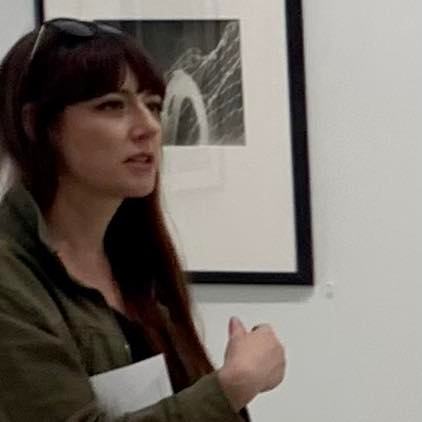
Zoe Spiliotis is a New Mexican based artist whose work is based on mathematical principles exploring the principles of repetition, symmetry, movement and visual perception through the use of patterns derived from her surrounding biological and built structures. Her work explores perception, the complexities and duality of life, and the quest for transcendence; creating a space where wonder meets the ordinary and where heavens meet earth.
Spiliotis earned an AS in Graphic Design from Valencia Community College, a BFA from Moore College of Art and Design in Philadelphia and an MFA from New Mexico State University. She exhibits nationally and internationally, and is represented in many collections across the country. She has also created number of public artworks in New Mexico, Texas, Pennsylvania and internationally in Venezuela. She was recently awarded a fellowship through the Humanities Collaborative UTEP-EPCC, funded by the Mellon Foundation for her project to develop a color identity for the City of El Paso. As an artist and educator she is a dedicated advocate for the arts, creating and promoting opportunities for her students, artists and the public. She serves on many local and national committees and is a member of the Border Artists, a non-profit collective which promotes arts in the binational region.
I am interested in ways of experiencing and depicting space: complex spaces, multiple spaces, paradoxical spaces, which encourage the viewer, through unlimited visual explorations, to contemplate duality and alternate universes/realities. The goal is to embody the intricate, multiply connected, fluid, and subtly ordered spaces that we feel are part of our realities. My work is based on mathematical principles as a source for form, both artistically and conceptually.
The repetitive patterns created by simple forms create extensive visual compositions of remarkable complexity, challenging the viewer to analyze it. These tense, continually active figure-ground compositions reflect modernist aesthetics where every portion of a painting is of equal importance and treated with equal intensity. In the works, the repetition of pattern becomes its own space, tessellated, with each shape supporting every other shape until they have no existence without each other. The undulating patterns and colors create an event where their ephemeral mutations both create color and change with the viewers movement. Because these events unfold in time and space, the viewer is free to discover their ability to create or destroy color and their understanding of reality, with their own perception from monocular cues.
Multiple formations can be continually discovered within the amount of time spent moving about the paintings. The use of patterns allows me to present images with constantly changing focus and appearance.The ordering of forms, colors and reflective surfaces depends on their effectiveness in creating a transcendental artistic event with visual illusions of optics and rhythmic combinations of color and pattern. My work reflects a recurrent theme in philosophy, theology, art and mathematics, which is the ongoing struggle to grasp the ideal and the transcendental and to encompass the infinite.